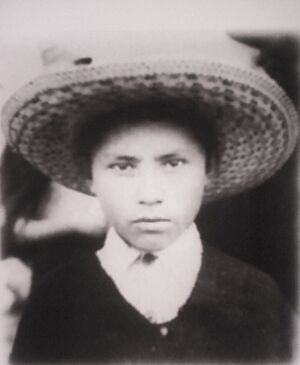Cabildo Mayor del Pueblo Muisca facts for kids
| Named after | Muisca |
|---|---|
| Formation | September 22, 2002 |
| Founded at | Bosa, Bogotá |
| Type | Indigenous organisation |
| Purpose | Education and culture Health, territory and environment Interethnic relations Linguistics |
| Headquarters | Bosa, Bogotá |
|
Region
|
Altiplano Cundiboyacense Boyacá, Cundinamarca |
|
Official language
|
Muysccubun, Colombian Spanish |
|
Parent organization
|
ONIC |
The Cabildo Mayor del Pueblo Muisca is an important group for native people in Colombia. It specifically helps the Muisca. This organization started in September 2002 in Bosa, Bogotá. It is part of the National Indigenous Organization of Colombia (ONIC). The Cabildo Mayor works to protect the rights of Muisca descendants. It also helps keep their culture, history, land, health, and the Muisca language (Muysccubun) alive.
Contents
Who are the Muisca People?
The Muisca were the native people of the Altiplano Cundiboyacense. This is a high plateau in the Eastern Mountains of the Colombian Andes. The word "Muisca" means "people" or "person" in their language, Muysccubun. They lived in fertile areas like the Bogotá savanna. Spanish explorers first called them "Muisca" when they arrived in 1537.
Muisca History and Spanish Arrival
The Muisca people were part of the Chibchan languages family. Their main leader was the zipa of Bacatá. The Spanish arrived in 1537 and conquered the Muisca. The zipa at that time was Tisquesusa. He died in April 1537. His successor was the last zipa under Spanish rule.
The Spanish founded Bogotá on August 6, 1538. After the main Spanish leaders left, Hernán Pérez de Quesada took charge. He treated the native people very badly. The last Muisca ruler, Tundama, was killed in December 1539.
Life Under Spanish Rule
During the time of Spanish rule, the Muisca were forced to work. They had to pay tributes in gold and emeralds. They also worked in emerald, coal, and salt mines. The Spanish also tried to convert them to Christianity. The last public Muisca religious ceremony happened in 1563.
Many Muisca people died from European diseases like smallpox. The Spanish also encouraged marriages between native people and Europeans. This led to a mix of cultures. The Muisca language was thought to be lost by the late 1700s. However, people are now working to bring it back.
The Cabildo Mayor del Pueblo Muisca Today
Many native groups in Colombia formed their own councils, called cabildos, starting in 1989. In 1999, Muisca communities discussed how to organize themselves.
From September 20 to 22, 2002, Muisca communities met in Bosa. These communities were from Bosa, Suba (in Bogotá), and Cota, Chía, and Sesquilé (in Cundinamarca). They created the Cabildo Mayor del Pueblo Muisca. This group joined the National Indigenous Organization of Colombia (ONIC). The Cabildo Mayor also supports Muisca communities in other towns. These include Ubaté, Tocancipá, Soacha, Ráquira, and Tenjo.
In 2010, two kindergartens were opened for Muisca children. This helps them learn about their heritage.
What the Cabildo Does
The Cabildo Mayor works in five main areas:
- Education and Culture: Helping Muisca children learn about their history and traditions.
- Health: Working to improve health for Muisca people.
- Interethnic Relations: Building good relationships with other groups.
- Territory and Environment: Protecting Muisca lands and the natural world.
- Linguistics: Bringing back and teaching the Muysccubun language.
See also
 In Spanish: Cabildo Mayor del Pueblo Muisca para niños
In Spanish: Cabildo Mayor del Pueblo Muisca para niños




